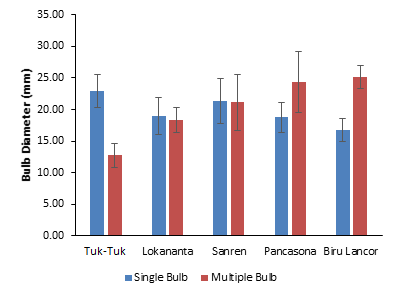
Growth and yield of five prospective shallot selected accessions from true seed of shallot in lowland areas
Endang Sulistyaningsih(1*), Retno Pangestuti(2), Rini Rosliani(3)
(1) Department of Agronomy, Faculty of Agriculture, Universitas Gadjah Mada Jln. Flora no. 1, Bulaksumur, Sleman, Yogyakarta 55281
(2) Assessment Institute for Agricultural Technology of Central Java Jln. Soekarno Hatta KM 26, No 10, Bergas, Kabupaten Semarang 50552
(3) Indonesian Vegetables Research Institute (IVEGRI) Jln. Tangkuban Perahu 517, Lembang, West Java 40391
(*) Corresponding Author
Abstract
True seed of shallot (TSS) from open pollination crossing are in the heterogenous as a result of the heterozygous parents. This condition gives the opportunity to obtain new selected accession through the genetic variations of their seedlings. Five TSS cultivars of Biru Lancor, Pancasona, Tuk-Tuk, Lokananta, Sanren were used as planting materials to be evaluated the growth and bulb yield performance for the selection of excellent shallot selected accessions in bulb production. The 300 seeds of each cultivar were planted in the field of Faculty of Agriculture, Universitas Gadjah Mada, Banguntapan, Bantul District, Yogyakarta (100 m above sea level). All seedlings were observed for the survival rate, plant growth, and development of bulb. The results showed that the seedlings of Sanren, Lokananta, Pancasona, Tuk-Tuk, and Biru Lancor could germinate with different survival rate of 88%, 87%, 80%, 67.3% and 48%, respectively. There was a significant difference in number of leaves that effected in developing a single bulb and multi-bulb. Prospective selected accessions with high yield in lowland areas was as follows: Biru Lancor 12 plants (4%), Pancasona 20 plants (6.7%), Sanren 146 plants (48.7%), and Lokananta 25 plants (8.3%). All of the selected bulbs will be planted again for further evaluation in excellent trait of bulb aggregation (bulbs multiplication).
Keywords
Full Text:
PDFReferences
Abbey, L., R. Kanton and H. Braimah. 1998. Susceptibility of shallots to the timing and severity of leaf damage. Journal of Horticultural Science & Biotechnology, 73:803-805.
Badan Pusat Statistik. 2018. Directorate general of horticulture, Indonesian Ministry of Agriculture. http://www1.pertanian.go.id/ap_pages/mod/datahorti.
Basuki, R.S. 2009. Analisis Kelayakan teknis dan ekonomis teknologi budidaya bawang merah dengan benih biji botani dan benih umbi tradisional. Jurnal Hortikultura, 19: 5-8.
Brewster, J.L. 2008. Onions and other Vegetable Alliums. 2nd ed. Wallingford, UK: CABI
Brink, V. L. and R.S. Basuki. 2012. Production of true seed shallots in Indonesia. Acta Horticulturae, 958: 115-120.
Damte, T., G. Tabor, M. Haile, G. Mitiku, and T. Lulseged. 2017. Determination of technology for shallot beginning of bulb enlargement time in shallot, Allium cepa var aggregatum for managing onion thrips (Thrips tabaci). Scientia Horticulturae, 220: 154-159.
Darsan, S., E. Sulistyaningsih, and A. Wibowo. 2016. Various shallot seed treatments with trichoderma to increase growth and yield on sandy coastal. Ilmu Pertanian, 1: 94-99.
Hidayat, T., P. Yudono, E. Sulistyaningsih, and A. Wibowo. 2018. Growth and yield of shallot (Allium cepa L. Aggregatum group) with application of beneficial microorganism. Ilmu Pertanian, 3: 66-71.
Heskiel, A. 2015. Fertility and variability of true seed of shallot (Allium cepa L. Aggregatum group) produced in lowland. Faculty of Agriculture, UGM. Yogyakarta. (Thesis).
Masuzaki S., N. Yaguchi, N. Yamauchi and M. Shigyo. 2007. Morphological characterization of multiple alien addition lines of allium reveals the chromosomal locations of gene(s) related to bulb formation in Allium cepa L. The Journal of Horticultural Science and Biotechnology, 82:393-396.
Prayudi, B, E. Sulistyaningsih, R. Rosliani, A. Mulyani, R. Pangestuti dan A.C.Kusumasari. 2014. Perbaikan Teknologi Perbenihan Bawang Merah Melalui Biji (TSS) di Tingkat Petani Mendukung Program Mandiri Benih. Laporan Kerjasama Penelitian KKP3SL. Semarang: Balai Pengkajian Teknologi Pertanian Jawa Tengah
Putrasamedja. 2011. Pengaruh pembentukan anakan pada bawang merah generasi ke 3 yang berasal dari umbi TSS. Agronomika, 11: 211-216
Rabinowitch, H.D., and R. Kamenetsky. 2002. Shallot (Allium cepa, aggregatum group).In: Rabinowitch, H.D., Curah, L. (Eds.), Allium Crop Sciences: Recent Advances. Wallingford, UK: CABI
Rosliani, R., I.M. Hidayat, I. Sulastrini, and Y. Hilman. 2016. Dissemination of technology for shallot (allium ascalonicum l.) seed production using true shallot seed (TSS) in Indonesia. Acta Horticulturae, 1143: 345-351.
Tashiro, Y., S. Miyazaki, and K. Kanazawa. 1982. On the shallot cultivated in the countries of southeast asia. Bulletin of the Faculty of Agriculture Saga University, 53: 67–73.
Article Metrics
Refbacks
- There are currently no refbacks.
Ilmu Pertanian (Agricultural Science) ISSN 0126-4214 (print), ISSN 2527-7162 (online) is published by Faculty of Agriculture Universitas Gadjah Mada collaboration with Perhimpunan Sarjana Pertanian Indonesia (PISPI) and licensed under a Creative Commons Attribution-ShareAlike 4.0 International License.












_2025_-_kecil_.png)
_2024_kecil_2.png)
